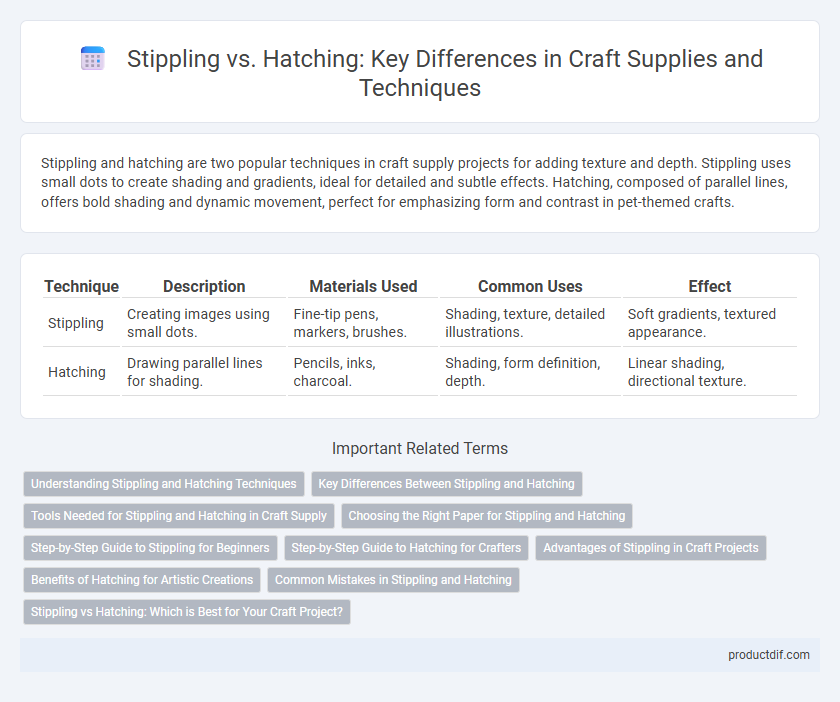Stippling and hatching are two popular techniques in craft supply projects for adding texture and depth. Stippling uses small dots to create shading and gradients, ideal for detailed and subtle effects. Hatching, composed of parallel lines, offers bold shading and dynamic movement, perfect for emphasizing form and contrast in pet-themed crafts.
Table of Comparison
| Technique | Description | Materials Used | Common Uses | Effect |
|---|---|---|---|---|
| Stippling | Creating images using small dots. | Fine-tip pens, markers, brushes. | Shading, texture, detailed illustrations. | Soft gradients, textured appearance. |
| Hatching | Drawing parallel lines for shading. | Pencils, inks, charcoal. | Shading, form definition, depth. | Linear shading, directional texture. |
Understanding Stippling and Hatching Techniques
Stippling and hatching are two fundamental techniques used in craft supply art to create texture and shading. Stippling involves applying countless small dots to build depth and contrast, while hatching uses closely spaced parallel lines to achieve similar effects. Mastery of these techniques enhances detailed artwork by manipulating light and shadow through varied density and spacing of dots or lines.
Key Differences Between Stippling and Hatching
Stippling uses numerous small dots to create shading and texture with gradual tonal variation, while hatching employs parallel lines to build depth and form. The density and spacing of dots in stippling control darkness, contrasting with hatching's reliance on line closeness and direction for shading effects. Stippling often produces a softer, more granular look, whereas hatching delivers a linear, structured appearance in craft and art projects.
Tools Needed for Stippling and Hatching in Craft Supply
Stippling requires fine-tipped pens or markers, such as micron pens or technical drawing pens, to create precise dot patterns essential for texture and shading in craft projects. Hatching demands a range of pencils or fine liners with different hardness levels, enabling artists to produce varied line densities and achieve depth through parallel or cross-hatched strokes. Both techniques benefit from high-quality paper that can withstand multiple layers without bleeding or tearing, ensuring clean and durable results in craft supplies.
Choosing the Right Paper for Stippling and Hatching
Choosing the right paper for stippling and hatching is crucial to achieving detailed and precise results, with smooth, heavyweight paper being ideal for fine stippling due to its ability to hold ink without bleeding. Textured or lightly toothy paper enhances hatching by providing subtle grip that allows for controlled line variation and smooth ink flow. Acid-free, medium-weight cotton paper ensures durability and longevity, making it a preferred choice for both stippling and hatching techniques in craft projects.
Step-by-Step Guide to Stippling for Beginners
Stippling involves creating detailed textures and shading using countless tiny dots, offering more control over tonal variation compared to hatching's linear strokes. Beginners start by selecting a fine-tip pen, then practice applying evenly spaced dots, gradually building denser areas to achieve depth and dimension. Consistent pressure and patience are essential when mastering stippling techniques for crafting intricate designs in ink or pencil.
Step-by-Step Guide to Hatching for Crafters
Hatching involves drawing closely spaced parallel lines to create shading and texture, a technique widely used in craft designs for depth enhancement. Start by selecting your area, then draw light, evenly spaced lines following the form's contour, gradually increasing line density for darker effects. Consistent pressure and direction control are key to achieving smooth gradients and detailed craft illustrations.
Advantages of Stippling in Craft Projects
Stippling offers precise control over shading and texture, making it ideal for intricate craft projects that require detailed patterns. This technique uses dots to build gradients, providing a softer and more subtle effect compared to hatching's linear strokes. Stippling also minimizes harsh lines, enhancing the depth and realism of designs in various craft mediums like paper, wood, and fabric.
Benefits of Hatching for Artistic Creations
Hatching techniques offer artists enhanced control over shading and texture, allowing for the creation of depth and dimension in drawings. By varying line density and direction, crafters achieve realistic gradients and dynamic visual effects that enrich artistic compositions. This method is particularly beneficial in detailed craft projects, providing precision and versatility compared to stippling.
Common Mistakes in Stippling and Hatching
Common mistakes in stippling include applying dots too far apart, resulting in weak shading, and inconsistent dot size that disrupts texture. In hatching, errors often involve uneven line spacing and direction, which can create awkward or unnatural shadows. Mastery requires consistent pressure and deliberate placement to achieve smooth gradients and depth in both techniques.
Stippling vs Hatching: Which is Best for Your Craft Project?
Stippling and hatching are both popular techniques used in craft projects to create texture and shading, but stippling involves applying numerous small dots, while hatching uses parallel lines. Stippling offers a softer, more gradual gradient ideal for detailed and delicate designs, whereas hatching provides a stronger, directional shading effect suitable for bold, dynamic artwork. Choosing between stippling and hatching depends on the desired texture, level of detail, and overall aesthetic of your craft project.
Stippling vs Hatching Infographic

 productdif.com
productdif.com